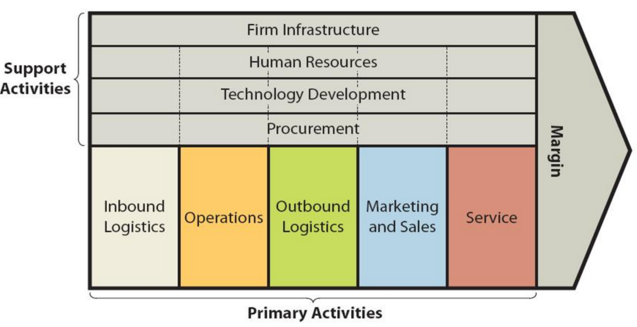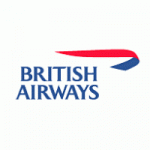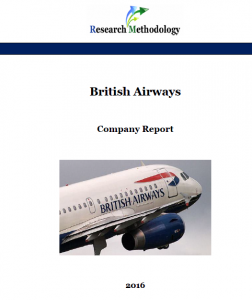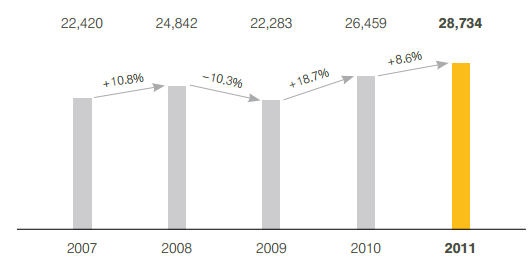Posts Tagged ‘Airlines’

British Airways value chain analysis involves the adoption of a systematic approach in the analysis of competitive advantage. The framework makes a distinction between primary and support business activities identifies the sources of competitive advantage for each activity. The figure below illustrates the essence of value chain analysis. Primary Activities Inbound logistics British Airways inbound logistics operations are complex and involve the timely delivery of fleet of planes, catering products and a wide range of other on-board products. The necessity to ensure the freshness of foods and drinks served during the flights further complicates British Airways inbound logistics primary activities. Competitive advantage is achieved in inbound logistics stage of the business by British Airways through establishing on-going relationships with suppliers, sophisticated system for stock control and professional training that has been accredited by UK City and Guilds. Operations Generally, operations stage of the business involves preparing goods and services to be sold to customers. As the UK’s largest international scheduled airline, British Airways flies globally to more than 400 destinations. Therefore, the scope of its business operations is extensive. British Airways has a range of competitive advantages in operations part of the business through offering its customers increased security for their luggage, offering quick check-in services and also offering some services such as ticket bookings and online booking of other services. Moreover, a high level of customization of service provision and an extensive utilization of digital technologies in a wide range of business processes represent solid sources for additional value for British Airways. Outbound logistics Outbound logistics involves sending ready products to customers for consumption. Although outbound logistics mainly relate to manufacturing companies, it is also applicable towards service businesses such as airlines. British Airways flies to airports in nearly 80 countries worldwide. The airline derives value in outbound…

British Airways segmentation, targeting and positioning refer to ways in which the airline company identifies certain individuals among the general public to offer their service packages. Segmentation involves dividing population into groups according to certain characteristics, whereas targeting implies choosing specific groups identified as a result of segmentation to sell products. Positioning refers to the selection of the marketing mix the most suitable for the target customer segment. British Airways follows multi-segment concentration marketing strategy by offering four different service packages to different customer segments. Specifically, British Airways targets different customer segments for its four levels of services: economy, premium economy, executive and first class. The following table illustrates segmentation, targeting and positioning of each category of British Airways services: Segmentation bases Target segment Economy class Premium Economy Executive Club First Class Geographic Region Domestic flights in UK Europe and international flights Selected international flights Europe and international flights Selected international flights Density Urban & rural Urban & rural Urban Urban Demographic Age Kids, teenagers, middle-aged, old-aged Teenagers, middle-aged Middle-aged, old-aged Middle-aged, old-aged Gender Male, female Income Low Middle High High Occupation Students, salaried Students, salaried Businessmen Professionals Businessmen Professionals Education High school Bachelor’s Technical Bachelor’s Master’s Business schools Master’s Business schools Social status Low, middle Low, middle High High Family size Joint families Nuclear families Nuclear families Newly married Psychographic Lifestyle Moderate-orientated Moderate-orientated Achievement-oriented Achievement-oriented Personality Easygoing Easygoing Determined Ambitious Behavioural Occasions Regular travel Vacations Business trips Honeymoon Business trips Benefits sought Affordability Value Luxury Convenience Luxury User status Regular traveller Regular traveller First timer, Regular traveller First timer, Regular traveller Attitude Indifferent Indifferent positive Positive enthusiastic Enthusiastic Travel and tourism industry base Customer expectations Low Medium High High Customer image Neutral Neutral to positive Positive…

British Airways (BA) is the largest airline company in the UK and it flies globally to more than 400 destinations to airports in nearly 80 countries. British Airways is a part of International Airline Group (IAG) that also owns three other airline brands – Aer Lingus, Iberia and Vueling. The Group also owns 13.55 per cent of the equity of IB OpCo Holding S.L. (“Iberia”) and 86.26 per cent of the equity of Avios Group (AGL) Limited (“AGL”). IAG made a record profit of GBP 1,264 million in 2015. By the end of 2015, British Airways had 39,304 employees globally (Annual Report, 2015). British Airways pursues service differentiation business strategy and differentiates its services via an extensive reliance on digitalization and information technology and high level of customization of service provision. These points represent solid sources of British Airways’ competitive advantage. Major weaknesses related to British Airways include an overdependence on the UK market and low profitability of business operations. At the same time, the airline is presented with the opportunities of forming strategic cooperation with other businesses in airline and catering industries, further engaging in international market expansion and benefiting from synergy via closer integration between IAG’s operating airlines. British Airways Report contains the application of the major analytical strategic frameworks in business studies such as SWOT, PESTEL, Porter’s Five Forces, Value Chain analysis and McKinsey 7S Model on British Airways. Moreover, the report contains analyses of British Airways’ business strategy, leadership and organizational structure and its marketing strategy. The report also discusses the issues of corporate social responsibility. 1. Introduction 2. Business Strategy 3. Leadership 4. Organizational Structure 5. SWOT Analysis 5.1 Strengths 5.2 Weaknesses 5.3 Opportunities 5.4 Threats 6. PESTEL Analysis 6.1 Political Factors 6.2 Economic Factors 6.3 Social Factors 6.4 Technological Factors 6.5 Environmental Factors 6.6…

1. Introduction Mergers, acquisitions and formation of alliances are commonplace in global airline industry and they are fuelled by the search of competitive advantages in order to achieve long-term growth. However, the implementation of mergers, acquisitions and formation of strategic alliances in practice can be associated with a set of complex challenges that might include differences in organisational culture, clash of personalities within top level management, lack or absence of strategic fit between the two companies and others. Lufthansa Group is a global airline company that employs more than 120,000 workforces that have contributed to generate 713 million EURO through serving 100.6 million passengers during the year of 2011 alone (Annual Report, 2011). Germanwings is a budget airline company that employs 1355 members of staff and served 7.52 million customers in 2011 offering flights to more than 90 destinations with 33 Airbus A 319 airplanes (Facts and Figures, 2013, online). Germanwings is wholly owned by Lufthansa since 2009. This report investigates a range of business issues related to the acquisition of Germanwings by Lufthansa German Airlines in 2009. The report starts with analysis of motives for choosing acquisition method among other alternatives by Lufthansa. This is followed by discussions of strategic and organisational fit between Lufthansa and Germanwings. Moreover, this report addresses potential gains and risks faced by Lufthansa due to the acquisition of Germanwings. The report is concluded with assessing outcomes relative to expectations in relation to this specific airline acquisition. 2. The Motives for Choosing Acquisition Method by Lufthansa Top level management of Lufthansa have selected the method of acquisition among other alternatives such as initiating a merger or forming a strategic alliance in relation to Germanwings due to the set of reasons that include less time required to complete the acquisition, increasing the market share, overcoming entry…
